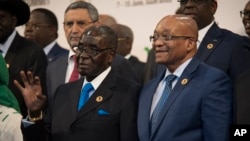Economists are warning that Zimbabwe’s current account deficit will rise significantly owing to the weakening of the South African rand.
South Africa is Zimbabwe’s biggest trading partner and Harare, which uses a basket of foreign currencies since it ditched its own currency in 2009, also uses the rand. The rand has plunged to an all-time low breaching 14 to the dollar on the back of a global drop in commodity prices.
Chief economist Prosper Chitambara of the Labour and Economic Development Research Institute of Zimbabwe says what happens in Pretoria has a domino effect on Harare.
Chitambara said, “The weakening of the rand has had a deleterious impact on Zimbabwe’s trade and current account sustainability and I think it has actually meant that imports are cheaper, whilst our exports are expensive.
“So, I think we have witnessed an erosion of current account sustainability and obviously that also affects the external imbalances vi-a vis the issue of the external debt, because once you continue to run a current account deficit, the implication is that it has to be financed from somewhere and we have no access to siegniorage, so I think its money that it has to be borrowed from somewhere. It’s something that does not augur well for the macro economics of Zimbabwe going forward”.
South Africa’s rand has hit new record lows as the prospects of a U.S rate hike hardened, a development that helped push stocks higher as money flowed into rand hedges such as the gold sector.
Businessman and former president of the Confederation of Zimbabwe Industries, Callisto Jokonya, said Zimbabwe is now paying the price of not having its own currency.
“The rand is a South African currency which is run by the South African government through their own Reserve Bank. So, in running a currency, every country tries to manage its own economic growth, it also tries to manage its own resources of the nation in general. And so there are always risks in terms of using anyone’s currency which you are not controlling.”
Reuters reports that the rand “staged a modest recovery on Tuesday after tumbling to a new record low, helped higher by a pause in the dollar's run to a seven-month peak.
“At 0640 GMT the rand had edged up 0.2 percent to 14.2700 per dollar, but will struggle to hold on to the gains as the likelihood of an interest rate hike in the U.S. increases, with another Federal Reserve member hinting at a December liftoff”
Zimbabwe's total debt, which is seen as blocking new funding for its stuttering economy, stands at $10 billion or 54% of gross domestic product after verification with the external debt accounting for 90% of the figure, Finance Minister Patrick Chinamasa said late last year.
Among the creditors are multilateral institutions – AfDB which is owed $597 million with arrears amounting to $519 million, ADF Bank at $58 million (arrears $16 million), Afrexim Bank $20 million, BADEA $20 million, World Bank $833 million (arrears $828 million), IDA $563 (arrears $205 million).
The European Development Bank is owed $314 million with arrears amounting to $278 million and IMF $125 million.
Creditors under the Paris Club are owed a total of $3,3 billion. And these are Austria, Belgium, Finland, France, Germany, Italy, Japan, Netherlands, Norway, Spain, Sweden, Switzerland, United Kingdom and United States.
The non-Paris bilateral creditors - China, Kuwait and South Africa are owed $692 million with the largest debt owed to China at $666 million.






